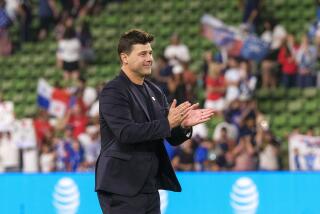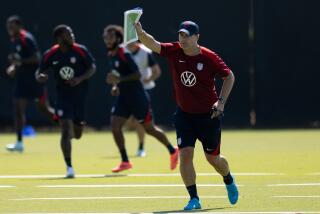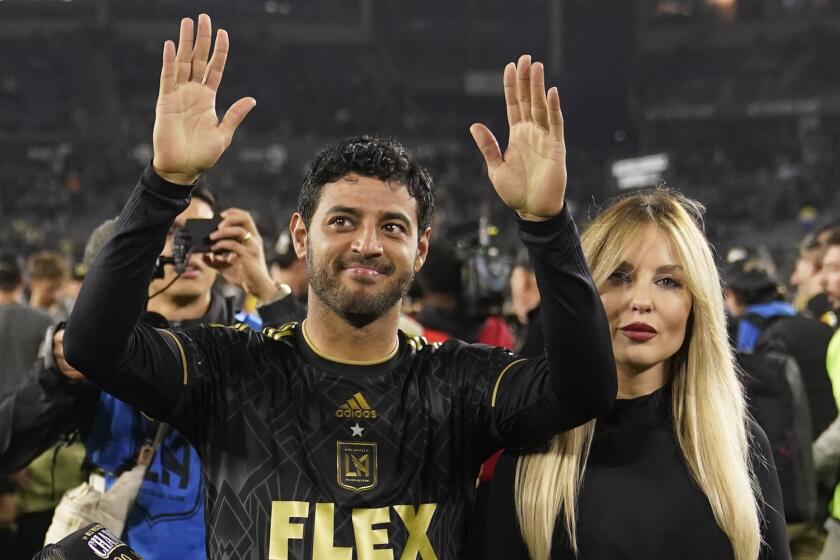Column: Is it time for a former player to run U.S. Soccer?
Being able to run fast and jump high are pretty important skills for a world-class athlete. But apparently not so much for the people who run the leagues those athletes play in — none of the commissioners of the country’s top six professional leagues played the game they now rule.
That makes the crowded ballot for president of the U.S. Soccer Federation an unusual one. Of the eight candidates standing for election this February, four have played for a U.S. national team (three of the four played in a World Cup and one is a world and Olympic champion). Two others played professionally and one was a goalkeeper in college.
Scott Minto, director of the Sports Business MBA program at San Diego State, sees nothing wrong with that.
“It’s possible to have a former athlete do that and be very successful,” he said of stepping up to the sport’s top executive post in the U.S. “Knowing the game is obviously something that adds a lot of credibility.”
Few corporate CEOs started off in the mail room, though, the soccer equivalent of trying to go from AYSO player to president of the federation. But Kyle Martino, a former Galaxy midfielder who earned eight caps with the national team, said the job now demands a from-the-bottom-up mentality.
“The hardest job anyone who becomes president is going to have is reestablishing trust with the members that the federation actually serves them,” said Martino, who left his job as an analyst with NBC to run for president. “And I think a former soccer player is uniquely positioned to do that.
“I’ve seen the game at every single level. … I’m a soccer player for life. As a player I can give back.”
The election to replace Sunil Gulati, who is not running for reelection after serving three four-year terms, comes at a critical time for U.S. Soccer. This fall a veteran-heavy U.S. team failed to qualify for the World Cup for the first time in 32 years, exposing deep cracks in the foundation of the game in this country.
And because of that, the race has drawn a large and eclectic field.
Besides Martino, the ballot includes former national team players Eric Wynalda, Paul Caligiuri and Hope Solo; lawyers Steve Gans, who played indoor soccer, and Michael Winograd, who played in Israel; Carlos Cordeiro, a former Goldman Sachs executive and longtime USSF board member who last year was elected the federation’s executive vice president; and Kathy Carter, a former college player who is now president of Soccer United Marketing, the marketing arm for both MLS and the USSF.
Two candidates — Solo and Carter — are women. The federation’s previous 11 presidents were men.
The U.S. Soccer Federation, which grew to a $100-million enterprise with more than 170 full-time employees under Gulati, a Columbia economics professor, is responsible for a broad range of duties, from running senior and age-group national teams for men and women to coaching education and referee administration. But it’s a mandate that may have become too large and complex.
The federation’s inability to find and develop young talent has been hampered by a lack of both qualified coaches and challenging programs in which to play. In addition, youth soccer’s pay-to-play model prices the game beyond the reach of many lower-income families, allowing thousands of talented kids to slip through the gaps.
The USSF has also been criticized for lacking transparency and oversight and for a growing disconnect between the top of the pyramid and those working at the grassroots level, something that has further hindered development.
That makes the first contested election for the federation’s presidency since 1998 a battle not only for the game’s future, but for its soul.
“It’s clear that we need a vision, a soccer vision. And someone who basically is qualified to almost be a technical director because we haven’t had that,” Martino said. “We’ve had a president unilaterally making technical decisions that he was unqualified to make.
“We’re at an inflection point and if we don’t have the right leadership, we could forever stymie the progress of this game.”
Who is best-suited to deliver that leadership will be decided Feb. 10 in the ballroom of an Orlando, Fla., hotel by approximately 550 voters representing youth, adult, pro and athletes councils as well as USSF board members, life members and a fan representative.
“It almost would be beneficial to have someone who has a passionate feeling and can get people riled up; that is a former player,” Minto said. “Those candidates really intrigue me. It could be just what it needs [is] to have a face that’s marketable, that people recognize, that played at high levels.“
Despite the federation’s shortcomings, it’s unlikely anyone would be talking about a new direction if Clint Dempsey’s second-half shot in October’s qualifying loss to Trinidad and Tobago had gone in rather than hitting the post. A goal would have sent the U.S. to the World Cup and punted any discussion about change down the road a couple of years.
“That’s what this failure has given us,” Martino said. ”An incredible gift, an incredible opportunity to take a low point and make it a pivotal moment,” he said. “We can move forward on a better path. We can become a better federation.
“That decision maybe comes down to do we elect the business person who’s going to hire the soccer person or do we elect the soccer person that’s going to hire a business person? The short answer is it’s much easier to find a business person than it is to find the capable soccer person.”
Follow Kevin Baxter on Twitter @kbaxter11








